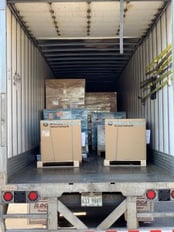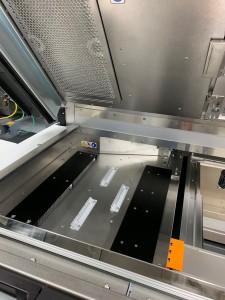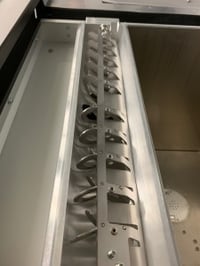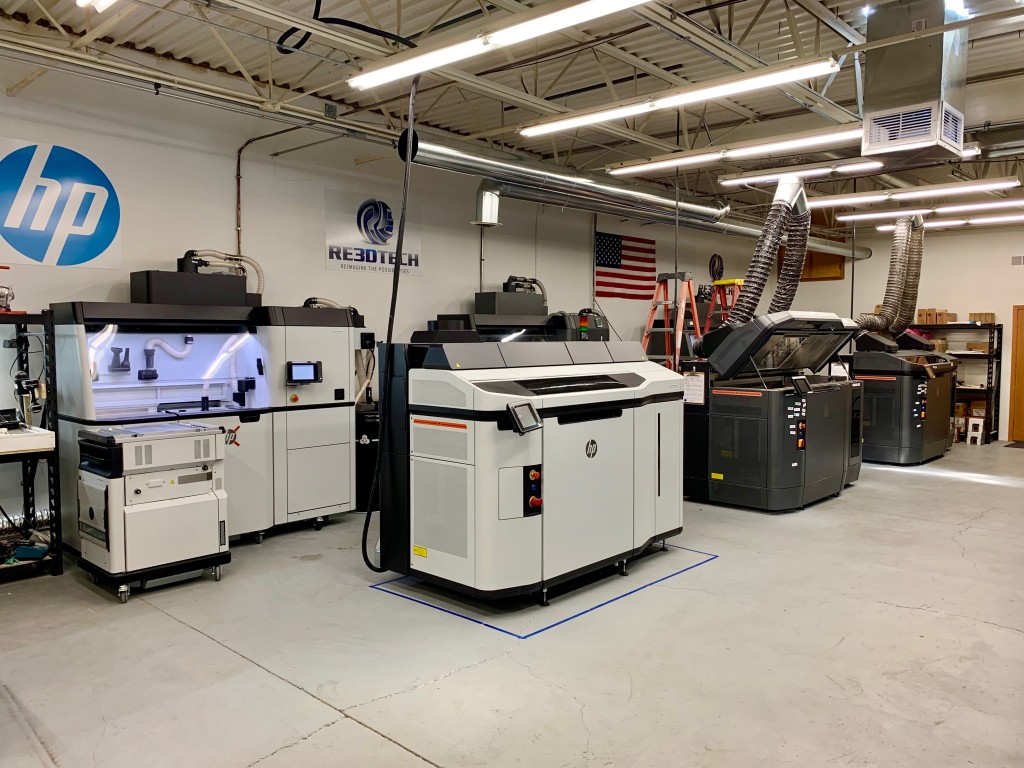Although I've experienced an Un-boxing of several Additive Manufacturing (AM) technologies over my career, this one feels different.

Leading up to the New HP Multi Jet Fusion (MJF) 5210 hitting the shop floor of Re3DTech, I couldn't help but to feel overwhelmed in anticipation, unsettling given the financial risk our company was about to take on, and pride in being one of the first to purchase this new technology. As I do every day, I commuted to work ready to tackle another day in the Additive world. As I pull into the lot, I noticed a forklift parked in my parking spot, and instantly recognized today as the day we would take delivery of the brand new HP MJF 5210 3D Printing Solution. A rush of excitement, with a hint of uncertainty filled my being, as I walk into Re3DTech, just as the bay door opens.
 A huge truck was parked outside, and our team sprung into action to make room for the forklift as it began to lift huge pallets into our shop. One by one, our shop became consumed with HP Boxes everywhere, until the last and final box rolled in, containing our new HP 5210 printer. As the bay door closed, we stood there looking at the ocean of boxes and crates, with not only amazement and excitement, but also a deeper sense of financial uncertainty. This was a huge investment to make on the part of our company, but we knew it was necessary to provide our customers with the best quality parts, faster.
A huge truck was parked outside, and our team sprung into action to make room for the forklift as it began to lift huge pallets into our shop. One by one, our shop became consumed with HP Boxes everywhere, until the last and final box rolled in, containing our new HP 5210 printer. As the bay door closed, we stood there looking at the ocean of boxes and crates, with not only amazement and excitement, but also a deeper sense of financial uncertainty. This was a huge investment to make on the part of our company, but we knew it was necessary to provide our customers with the best quality parts, faster.
What are the benefits of the HP 5210 series over the HP 4210 Series?
A question we asked ourselves everyday during our purchase decision phase of bringing this new machine in-house. Presently, the machine is on our floor and it has become very apparent to us that HP considered user feedback and issues with the 4200 series, and made the necessary corrections. This is what we discovered, when unboxing the new HP MJF 5210 Printing Solution.
Enhancing Aesthetics
 HP MJF 5200 Series Printer
HP MJF 5200 Series Printer
- The first thing we tackled was the printer itself, and let me tell you, it looks amazing. Unscrewing the front plywood face of the printer, what immediately stood out was the color. I first described it as “Storm Trooper White”, hinting that this machine looked like it came straight out of a Star Wars movie, but the aesthetic of the color wasn't what did it for me, it was the simple fact that it was a great design element with intention other than that of aesthetic.
- The intentional design element on HP's part can be seen in the fact that the powder used to print the parts, is white in color. The powder inherently gets everywhere during the printing and post processing processes, so naturally, the printer itself will get covered in powder. In comparison, the 4210 series is a charcoal grey color, with that same white powder being used. The contrast between the grey color and the white powder, always seemed to make the machine look dirty, and often would be vacuumed. I have the feeling that this will not be the case with the new 5210 series, giving the machine a clean look, even though it might be covered in powder.
Double the Capacity of the 4210 Series
A full build on the 4210, would normally take about 16 hours to build, and the same full build on the 5210, will take around 11 hours to build.
- This equates to build times that are ~30% faster on the 5210 and will allow us to run 2 full builds on the 5210 system within 24 hours.
- This is due to the fact that the printer is now able to print bidirectionally, compared to the 4210 that prints from right to left, resets to the right, then prints the next layer from right to left.
The Progression of the next Industrial Revolution
The 4200 series was announced in May of 2016, and had been released to the public in June of 2017. To date, the 4200 series as been on customers shop floors for about 2 years, and it seems that HP has used what what they have learned about their first printers, and have made the necessary changes to the 5200 series. Here is what some of the problems were with the printer, and the changes they implemented in their 2nd Generation of 3D Printers:
Overheating:
 Heat Syncs & Print Head Cooling
Heat Syncs & Print Head Cooling
- 4200 Series: Using 4 separate fusing lamps, heat is applied to the fusing and detailing agents to create a chemical reaction between the agents and powder, ultimately creating the part. Being a detrimental variable in the MJF process, the 4200 series fusing lamps often experienced the same issues. If there was any fluctuation in the amount of energy given off by the lamps during the printing process, part quality issues would often arise. These issues are as follows:
- Not Enough Energy: Parts would often experience what we call elephant skin. In other words the powder and agents would not fuse together, due to low temperatures experienced in the build.
- Too Much Energy: Parts would often experience what is called, Thermal Bleed. Thermal bleed is the over heating of the powder bed, thus causing powder surrounding the part, to be sintered to the part itself.
- Broken Bulb Bust: If 1 of the 4 Fusing Lamps go out during a build, it he machine would kill the build, regardless of how far along in the build process it was.
- 5200 Series: Everything heating related on the 5200 series, has been addressed in the following ways
- Advanced Thermal Cameras that check the energy and heat experienced inside the machine at any given layer, and compensates for these factors for the next layer. Machine learning folks!
- In order to disperse unwanted accumulations of heat inside the machine, the 5200 has new features that allow it to have more control on the internal environment.
- Fusing Lamp Heat syncs & print head cooling inlets, allow for the machine to have more control over the internal printing environment
- Upgrade the Fusing lamp assembly to consist of 6 bulbs, 3 bulbs on each side of the carriage, and if 1 bulb goes out, it will NOT stop the job mid-build, but will increase the radiance in the other to bulbs to compensate.
Cooling:
- 4200 Series: Scheduling jobs for production and shipping using Additive Manufacturing is much more complicated than one would assume, because you are not just looking at the time it takes to build the parts, but how long it takes the parts to cool down, before post processing.
- Consider the numbers: If it takes 16 hours to produce a full build or parts, it takes that build 42-46 hours to naturally cool down.
- The real issue occurs when you consider, what the build is cooling down in, that being the build cart, and a build cart you cant print with again until the build is cooled and excavated.
- Consider the numbers: If it takes 16 hours to produce a full build or parts, it takes that build 42-46 hours to naturally cool down.
- 5200 Series: We were excited to see that we now have another alternative to cooling our builds, without taking our build carts out of commission for the next 42-46 hours. HP's answer to this is the natural cooling unit. The natural cooling unit is the same size and shape of the MJF's build envelope and fits right over the build cart. With the push of a button, the whole build is forced out of the build cart, and into the natural cooling unit, to be set on a shelf and naturally cooled. Upon transferring the build to the cooling unit, we are able to fill the build unit once again, and continue with production on the printer.
Build Cart:
 HP 4200 Series Sifter/Feeder Vane Assembly
HP 4200 Series Sifter/Feeder Vane Assembly
4200 Series: The creation of HP's MJF build cart, single handily changed the way the AM Industry thinks about production, because it eliminated the need to cool the builds inside the machine, and turned it into a plug and play production powerhouse. The industry experienced for the first time, a system that allows the printers to be run non-stop, that is if you have enough build carts in your production cycle. The very build cart that allows parts to be printed within its build chamber, is the same cart, that houses the plastic powder, and feeds it into the system. Its a very impressive little piece of technology, but that doesn't mean, that it comes without fault. Often we would experience break downs in our build carts, and a majority of the time, it had to do something with the material feeding mechanism. The powder is moved from the internal tank of the build cart, to feeder vanes, using a auger. Upon reaching the top, 2 things would happen, a shaker screen would help sift the powder, while also spreading the powder uniformly across the x-axis of the build cart. Next, the feeder vane, would lift the powder above the build plate, where a roller would spread the powder evenly throughout the build. The problem occurred when considering you now have two motors on each side of the build cart, two for the sifting component, and two for the the feeder vane movement. Add that up, and that is 4 motors that can go out at any given moment, and potentially kill your build.
-
 HP 5200 Series New Feeder Vane
HP 5200 Series New Feeder Vane
5200 Series: HP designed a new feeder vane, that not only feeds the roller, but also sifts/disperse the powder uniformly in the x axis, effectively eliminating 2 motors from potentially failing.
Its evident in the whole system, that HP did the leg work, and asked users the right questions, because a lot of things that were issues associated with the 4200 design, have been re-engineered in the 2nd generation of machines, the 5200 series. As we continue to learn more and more about this new machine to hit our shop floor, we will update this article to capture some of the things we might have missed un-boxing day, so stay tuned!
For more information, Visit: HP 3D Jet Fusion 5200 Series 3D Printing Solution
[/fusion_text][/fusion_builder_column][/fusion_builder_row][/fusion_builder_container]
Reach out to us via email if you have any questions, comments, or concerns and we will get back to you promptly
[ninja_form id=1]


